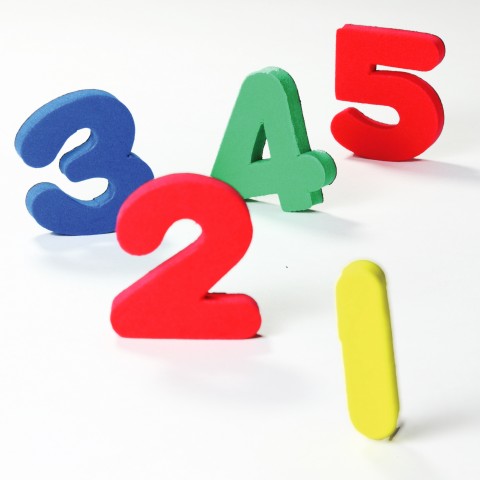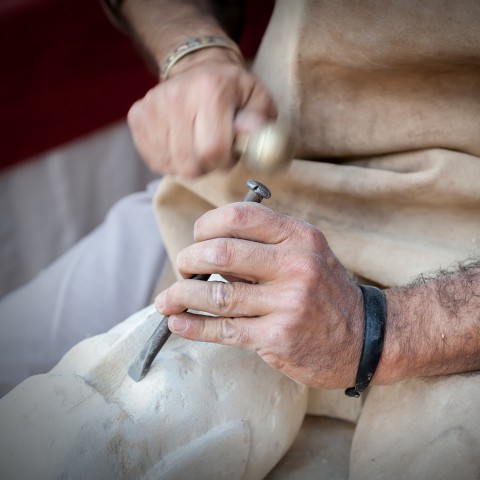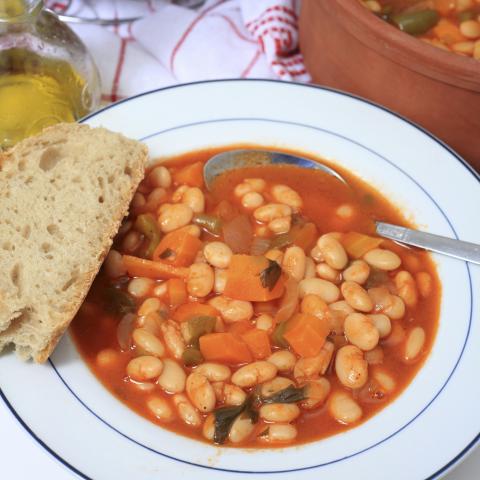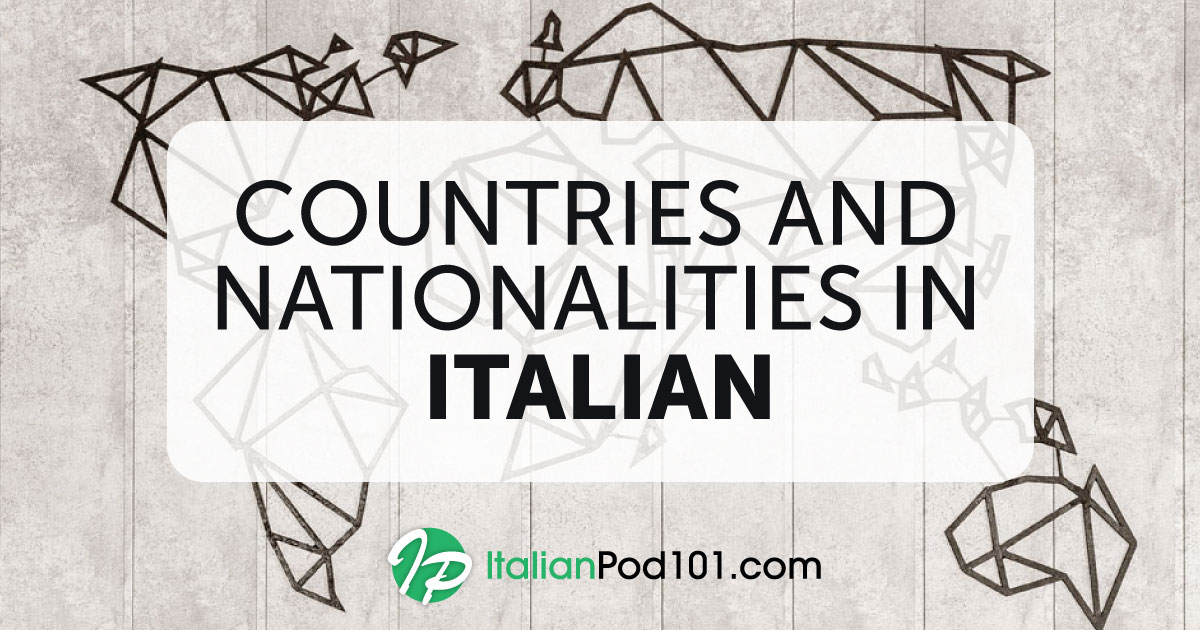
Mastering Italian is an ongoing process and a wonderful journey, but you’re definitely on the right track! Once you have secured the basics, it’s time to move on and tackle more complex grammar structures and vocabulary words.
The topic of this guide is Italian words for intermediate learners, and you’ll find a great variety of nouns, verbs, adjectives, pronouns, conjunctions, and more! We’ve included everything you need to improve your comprehension and to take part in more advanced conversations, watch movies without subtitles, or read books and magazines without a dictionary.
While this list is by no means complete, we recommend you begin practicing these intermediate Italian words right away. Remember that you can find more lessons and exercises on ItalianPod101.com—create your free lifetime account today to gain full access to our study materials.
Let’s get started!
 Table of Contents
Table of Contents
- Let’s Start with the Numbers
- Nouns
- Pronouns
- Verbs
- Adjectives
- Adverbs
- Prepositions
- Conjunctions
- Conclusion
1. Let’s Start with the Numbers
3… 2… 1… Via! (“Go!”)
The first set of intermediate words we’ll look at are the higher numbers. The first ten are quite easy—you just need to memorize them!
- → Check out this fun lesson if you need some refreshing on the Italian numbers from 1 to 10 before we start.

Diamo i numeri? (“Shall we give the numbers?”)
1 – From 11 to 20
The numbers from 11 to 20 are extremely useful when talking about the ages of your amici adolescenti (“teenage friends”), small prices, or the time.
| 11 | Undici |
| 12 | Dodici |
| 13 | Tredici |
| 14 | Quattordici |
| 15 | Quindici |
| 16 | Sedici |
| 17 | Diciassette |
| 18 | Diciotto |
| 19 | Diciannove |
| 20 | Venti |
There are a couple of things we should point out regarding the Italian numbers from 11 to 19.
1. They are formed by combining the word dici (a word meaning “ten”) and the unit number. But, as you probably noticed, dici looks a bit different from dieci (as there’s an “e” missing in there). Furthermore, it’s positioned after the units until the number se-dici (16), but before the units for the numbers 17, 18, and 19.
2. Notice also how we double the consonant in diciassette (17) and diciannove (19).
2 – Counting Up to 100
| 20 | Venti |
| 30 | Trenta |
| 40 | Quaranta |
| 50 | Cinquanta |
| 60 | Sessanta |
| 70 | Settanta |
| 80 | Ottanta |
| 90 | Novanta |
| 100 | Cento |
While the numbers up to twenty can be a bit tricky, counting up to cento (100) in Italian is fairly easy. Just put together the decine (“tens”) and the units: ventuno, ventidue, ventitre, ventiquattro (21, 22, 23, 24), and so on. They all follow the same pattern.
3 – To 1,000 and Beyond
Now, the big numbers—the ones you need to talk about large amounts of money—are really straightforward. You just have to remember that they form one word (no hyphen, no space) and that we use a period (.) rather than a comma (,) to write numbers from 1,000 onward: 1,234 = 1.234.
| 200 | Duecento |
| 300 | Trecento |
| (…) | |
| 900 | Novecento |
| 1,000 | Mille |
| 2,000 | Duemila |
| 10,000 | Diecimila |
| 100,000 | Centomila |
| 1,000,000 | Un milione |
If you want to check out more examples, read our full Italian numbers guide on ItalianPod101.com.
2. Nouns
In Italian, nouns are called sostantivi (that is, “substantive”).
Nouns have a fundamental function in communication. They allow us to name people, things, places, concepts, actions, feelings, ideas, and anything else we might want to refer to while speaking or writing. In short, nouns define everything that exists or that we can imagine, and therefore constitute an essential element of any sentence.
In Italian, each noun can be masculine or feminine and singular or plural. And don’t forget that they have to “agree” with other parts of speech in the sentence, such as articles or adjectives.
Let’s now see some intermediate Italian vocabulary words you can use at school, in the workplace, or in your spare time.
- → To see even more nouns along with audio recordings of their pronunciation, make sure to visit our vocabulary list on the 50 most common Italian nouns on ItalianPod101.com.
1 – Exercise
| La corsa | Running |
| In Italy, you might hear people saying faccio footing, which sounds English—but it’s not! This is one of the many Itanglish words that have been misused over the years. | |
| Attività fisica | Exercise |
| In Italian, there is no single word for general exercise, and we often think of it as andare in palestra (“to go to the gym.”) | |
What do we call the different kinds of sports in Italian? Let us know in the comments which sport is your favorite (in Italian, of course).
Note that the verb used for practicing sports could be either giocare (“to play”) or fare (“to do”), depending on the sport in question. But which is which? Here we go:
| Calcio Pallacanestro Pallavolo Pallanuoto Tennis | Soccer Basketball Volleyball Water Polo Tennis |
| For all of these sports, we use the verb giocare (“to play”). Da piccola giocavo a pallacanestro. “When I was a kid, I played basketball.” | |
| Nuoto Ginnastica Atletica Ciclismo Sci | Swimming Gymnastics Track and field Cycling Skiing |
| For these sports, on the other hand, we use fare (“to do”). Ho fatto atletica per tanti anni. “I practiced track and field for many years.” | |
| Un gioco | A game |
| Una partita | A match |
| Il punteggio | The score |
| La vittoria | The victory |
| Un infortunio | An injury |

E tu, che sport fai oggi? (“And you, what sport are you doing today?”)
2 – The Workplace
| Un lavoro | A job |
| La pausa caffè | The coffee break |
| Are you wondering why this is the second item on the list? Not only because coffee is soooo important for Italians, but also because the coffee break is the perfect moment for a creative, informal meeting among colleghi (“colleagues”). | |
| Un colloquio (di lavoro) | An interview |
| Una riunione | A meeting |
| La sala riunioni | The meeting room |
| L’ufficio | The office |
| La scrivania | The desk |
| La sedia | The chair |
| La mensa | The cafeteria |
3 – At School
| La classe / L’aula | The classroom |
| Lo zaino / Lo zainetto | The backpack |
| La penna | The pen |
| La matita | The pencil |
| Il libro di testo | The textbook |
| Il quaderno | The notebook |
| Il banco | The desk |
| La cattedra | The teacher’s desk |
| La lavagna | The blackboard |
| Il dizionario | The dictionary |
| Il righello | The ruler |
| L’astuccio | The pencil case |
4 – Arts, Crafts, and Hobbies
| Il disegno | The drawing |
| Il dipinto | The painting |
| La scultura | The sculpture |
| La composizione | The composition |
| L’orchestra | The orchestra |
| La chitarra | The guitar |
| Il violino | The violin |
| La danza | The dance |
| La coreografia | The choreography |
| L’artigianato | The crafts |

Mani esperte (“Expert hands”)
5 – At the Doctor’s
| Il dottore / La dottoressa | The doctor |
| Il dentista | The dentist |
| L’ospedale | The hospital |
| La medicina | The medicine |
| La cura | The cure |
| Il mal di testa | The headache |
| Il mal di denti | The toothache |
| Il mal di stomaco | The stomachache |
| Le pillole | The pills |
| Il cerotto | The band-aid |
| L’ambulanza | The ambulance |
| Il vaccino | The vaccine |
3. Pronouns
Pronouns are fundamental when it comes to advancing your speaking skills and reaching an intermediate level of Italian. They help you avoid repeating the names of things and people over and over again.
There are many kinds of pronouns. Let’s start with the basics: personal pronouns.
As a beginner, you probably learned the personal subject pronouns (io, tu, lei, etc.). Now, to expand your intermediate Italian vocabulary, you’ll need to tackle the stressed, unstressed, direct, indirect, and reflexive personal pronouns. Here we go.
1 – Stressed Pronouns
Complement pronouns can be used in both stressed (forti) and unstressed (deboli) forms. The form you choose basically depends on how much emphasis you want to place on the pronoun. Let’s see a few examples.
You need to use the strong form of the complement pronoun when you want to give greater importance to the subject or to the complement. They’re generally placed after the verb.
For example:
Penso a te. → (stressed: “It is you I am thinking of.”)
Ti penso. → (unstressed: “I think of you.”)
Chiami me? → (stressed: “Is it really me you are calling?”)
Mi chiami? → (unstressed: “Do/can you call me?”)
And you always need a stressed form when you use the pronoun together with a preposition (di, a, da, con, etc.).
Vado con loro. (“I go with them.”)
Non mi ricordo di te… (“I don’t remember you…”)

Are you a stressed or an unstressed…pronoun?
| Person | Italian pronoun | English |
| 1st person sg. | me | me |
| 2nd person sg. | te | you |
| 3rd person sg. | lui / lei | he / him / she / her |
| 1st person pl. | noi | us |
| 2nd person pl. | voi | you |
| 3rd person pl. | loro | them |
2 – Direct, Indirect, and Reflexive Personal P
ronouns
If you don’t need to put particular emphasis on the person or thing you’re talking about, you’ll use an unstressed personal pronoun. In Italian, unstressed pronouns can be direct or indirect.
Direct pronouns replace direct object complements. In simpler terms, they answer the question “Who?” or “What?”
Chiamo Sara. (“I call Sara.”) → I call who? Sara. → La chiamo. (“I call her.”)
Mangio un gelato. (“I eat an ice cream.”) → I eat what? An ice cream. → Lo mangio. (“I eat it.”)
Indirect pronouns replace indirect object complements, and they answer the question “To whom?” or “To what?”
Telefono a Carlos. (“I make a call to Carlos.”) → To whom? To Carlos. → Gli telefono. (“I make a call to him.”)
Scrivo alla mia amica. (“I write to my friend.”) → To whom? To my friend. → Le scrivo. (“I write to her.”)
Reflexive pronouns are those that go with reflexive verbs [see verb section], and we use them when the object of a sentence is also its subject. It allows the action to fall upon the subject.
Mi alzo e mi lavo la faccia. (“I get [myself] up and I wash my face.”)
There is no equivalent in English, but the same idea is rendered by using “my, myself,” etc.
Notice how all of these pronouns are the same across the three types (direct, indirect, reflexive) except for the third person. This change takes place to distinguish between masculine and feminine forms.
| Person | Direct pronouns | Indirect pronouns | Reflexive pronouns |
| 1st sg. [m, f] | mi | mi | mi |
| 2nd sg. [m, f] | ti | ti | ti |
| 3rd sg. [m] | lo | gli | si |
| 3rd sg. [f] | la | le | si |
| 1st pl. [m, f] | ci | ci | ci |
| 2nd pl. [m, f] | vi | vi | vi |
| 3rd pl. [m] | li | gli | si |
| 3rd pl. [f] | le | gli | si |
3 – Relative Pronouns
Relative pronouns, like all pronouns, are used to replace the name of someone or something. Generally, they’re used to join sentences that have an element in common.
Mio fratello viene a trovarmi. + Mio fratello studia a Roma.
→ Mio fratello, che studia a Roma, viene a trovarmi.
(“My brother comes to visit me.” + “My brother studies in Rome.”)
→ (“My brother, who studies in Rome, comes to visit me.”)
Or:
Ti ho parlato di mio fratello. + Mio fratello studia a Roma.
→ Mio fratello, di cui ti ho parlato, studia a Roma.
(“I told you about my brother.” + “My brother studies in Rome.”)
→ (“My brother, whom I told you about, studies in Rome.”)
| che (“that” / “which” / “who”) | This is the easiest relative pronoun, as you can use it for almost anything, provided that there is no preposition. |
| il quale (“that” / “which” / “who”) | Compared to the one above, il quale is a bit more sophisticated and complex. It must be used with the article and agree with other words in the sentence. Mio fratello, il quale studia a Roma, arriva domani. “My brother, who studies in Rome, arrives tomorrow.” |
| cui (“that” / “which” / “who” / “where”) | This relative pronoun is used together with a preposition: La città in cui vivo. (“The city where I live.”) L’amico a cui hai scritto. (The friend you wrote to.”) Sei la ragione per cui vivo. (“You’re the reason why I live.”) |
4 – Indefinite Pronouns
Indefinite pronouns indicate, in an imprecise and generic way, the quantity of a thing or the identity of a person.
Some of them can also function as indefinite adjectives (if they precede the noun) and indefinite pronouns (if they replace the noun). Others are only used as indefinite pronouns.
| Qualcuno (“Someone”) | Qualcuno ha capito? (“Did someone understand?”) |
| Nessuno (“Nobody”) | Nessuno ha capito! (“Nobody understood!”) |
| Ognuno (“Each one” / “Everyone”) | Ognuno fa quello che può. (“Everyone does what they can.”) |
| Niente (“Nothing”) | Non ho capito niente… (“I understood nothing…”) |
| Qualcosa (“Something”) | Forse ho capito qualcosa. (“Maybe I understood something.”) |
| Un tale / Un tizio (“Somebody”) | Ieri ho incontrato un tale… (“Yesterday I met somebody…”) |
| We often use the expression tizio, caio, e sempronio to talk about generic people—those we don’t really know or who don’t mean much to us. For some reason, these three names were chosen in Ancient Rome to represent a Mr. Nobody… | |
- → To learn more about pronouns, their various categories, and how to use them, be sure to stop by our complete guide on ItalianPod101.com.
4. Verbs
At the beginner level, you learned a number of basic action words that allowed you to get your point across. These words may have been quite useful at first, but as your speaking and writing skills improve, you should start picking up some intermediate Italian verbs. Knowing these will help you sound more like a native speaker and give you the means to better express yourself.
1 – Reflexive Verbs
Reflexive verbs indicate that the subject of a sentence performed an action on itself. This type of verb is always used with reflexive pronouns [see previous section]. They’re extremely common in Italian, which means they’ll make an excellent addition to your intermediate Italian vocabulary.

Guardarsi allo specchio (“Look in the mirror”)
| Annoiarsi | To get bored |
| Arrabbiarsi | To get angry |
| Divertirsi | To have fun |
| Impegnarsi | To engage |
| Innamorarsi | To fall in love |
| Lamentarsi | To complain |
| Pettinarsi | To comb (one’s hair) |
| Preoccuparsi | To worry |
| Truccarsi | To put on makeup |
| Rilassarsi | To chill out |
| Sedersi | To sit |
| Sposarsi | To get married |
| Svegliarsi | To wake up |
| Vergognarsi | To be ashamed |
| Vestirsi | To get dressed |
2 – Verbs and Prepositions
Some verbs use simple and complex prepositions (preposizioni articolate) before the noun or the infinitive that follows them. But which preposition do we use? Di, da, a…? Unfortunately, there is no precise rule, and the only way to learn them is by heart.
Here’s a list of the most common verb-preposition pairs you’ll need to add to your intermediate vocabulary.
| Pensare a | To think to |
| Minacciare di | To threaten to |
| Fingere di | To pretend to |
| Dubitare di | To doubt of |
| Finire di | To finish to |
| Evitare di | To avoid to |
| Cominciare a | To start to |
| Abituarsi a | To get used to |
| Aiutare a | To help to |
| Andare a | To go to |
| Continuare a | To keep on |
| Imparare a | To learn to |
| Mettersi a | To start to |
| Provare a | To try to |
5. Adjectives
Adjectives are the perfect instruments to improve the way you express ideas. The more, the better. Here, we’ll just concentrate on possessive adjectives as well as comparatives and superlatives.
- → But for a great read on adjectives, don’t miss our article Top 100 Italian Adjectives on the ItalianPod101 blog.
1 – Possessives
Possessive adjectives in Italian are always preceded by an article, except when they’re followed by terms indicating a singular family member: mio fratello (“my brother”), tua sorella (“your sister”), etc.
They need to agree in gender and number with the noun, and their form doesn’t change even when they’re turned into pronouns.

La mia famiglia (“My family”)
| Italian Possessives | Adjective | Pronoun |
| il mio / la mia / i miei / le mie | my | mine |
| il tuo / la tua/ i tuoi / le tue | your | yours |
| il suo / la sua/ i suoi / le sue | his / her | his / her |
| il nostro / la nostra/ i nostri / le nostre | our | ours |
| il vostro / la vostra/ i vostri / le vostre | your | yours |
| il loro / la loro / i loro / le loro | their | theirs |
2 – Comparatives & Superlatives
In Italian, comparatives and superlatives are normally formed with più or meno (“more” or “less”) and the adjective. However, there are also some irregular forms that come directly from the Latin model.
| Migliore | Better |
| Ottimo | Great / Best |
| Maggiore | Bigger / Greater |
| Minore | Minor / Less |
| Superiore | Superior / Higher |
| Ulteriore | Further |
| Peggiore | Worse |
| Pessimo | Bad / Worst |
| Inferiore | Inferior / Lower |
6. Adverbs
Like with adjectives, you could get away with very few adverbs as a beginner, but you’ll need to learn some more as you level up. They’re not only great for showing style and sophistication in writing, but also for helping the audience picture how something is done when you’re having a conversation.
1 – When
| Già | Already |
| A lungo | A long time / Long |
| Adesso | Now |
| Ancora | Again |
| Finalmente | At last |
| Allora | Then |
2 – How Often
| A volte | Sometimes |
| Raramente | Rarely |
| Solitamente | Usually |
| Generalmente | Generally / Usually |
| Sempre | All the time |
| Mai | Never |
3 – Where
| Da nessuna parte | Nowhere |
| Da qualche parte | Somewhere |
| Altrove | Somewhere else |
| Su | Up / Above |
| Giù | Down / Below |
| Sopra | Over / On |
| Sotto | Under / Below |
| Lontano | Far |
| Vicino | Close |

Facciamolo…silenziosamente. (“Let’s do it…quietly.”)
4 – How
| Silenziosamente | Softly / Quietly |
| Lentamente / Piano | Slowly |
| Rapidamente | Fast / Quickly / Shortly |
| Con calma / Piano | Calmly / Quietly |
| Facilmente | Easily |
| Fortunatamente | Luckily |
| Semplicemente | Simply / Just |
5 – How Much
| Piuttosto | Rather |
| Abbastanza | Enough |
| Specialmente | Especially |
| Quasi | Almost |
| Quanto | How much / How many |
| Talmente | So / So much / So many |
| Circa | About / Approximately |
Take note of how many adverbs are formed by the [adjective + mente] pattern (rara-mente, general-mente, lenta-mente). Why don’t you give it a try? You can create a great number of adverbs to build upon your intermediate vocabulary! Or, you can find many more adverbs in our guide to the top 100 most useful Italian adverbs on ItalianPod101.com.
7. Prepositions
You don’t need too many prepositions, but they’re still vital when it comes to articulating your speech and structuring your sentences. They mark the relationships and links between people, objects, places, and moments.
1 – Time
| Prima | Before / Prior |
| Dopo | After / Then / Once |
| Fra | In / Within |
| Fra (which also means “between” or “among”) is used to talk about a period of time after which something will occur, as in: Vado in vacanza fra una settimana. (“I go on holiday in a week.”) The opposite is expressed with fa (“ago”): Siamo arrivati una settimana fa. (“We arrived a week ago.”) | |
| Da | Since |
| The preposition da (which also has many other meanings, such as “at,” “from,” etc.) is used to talk about how long (since) something has been happening. Vivo a Roma dal 2019. (“I’ve been living in Rome since 2019.”) | |
2 – Space
| Accanto | Next to / Beside |
| A destra | To the right |
| A sinistra | To the left |
| Da | At |
| Da is used to mean “at someone’s place or office.” For example: Dormo da un amico. (“I sleep at my friend’s house.”) Vado dal medico. (“I go to the doctor.”) | |
| Davanti | In front of / Ahead |
| Dietro | Behind |
| Sotto | Under |
| Sopra | Over / On |
8. Conjunctions
Conjunctions allow you to connect two (or more) words, clauses, or sentences together. They can also be used to clarify the relationship between one sentence and the next. They’re very cool because, by using conjunctions, you’re able to build more sophisticated phrases.
You may have learned the most basic conjunctions already (e, o, se, perché, ma), so we’ll just focus on the slightly more advanced ones here.

Né carne, né pesce… sono vegetariana! (“Neither meat nor fish… I’m a vegetarian!”)
Né…né (“Nor” / “Neither…nor” / “Either…or”)
- Non mangio né carne né pesce. (“I eat neither meat nor fish.”)
Quindi (“Therefore” / “So”)
- Sono stanca quindi vado a letto. (“I’m tired, so I’m going to bed.”)
Altrimenti (“Otherwise”)
- Studia, altrimenti mi arrabbio! (“Study; otherwise, I’ll get angry!”)
Poiché (“Since” / “As”)
- Poiché insisti, accetto il tuo invito. (“Since you insist, I accept your invitation.”)
Sebbene (“Although”)
- Sebbene sia stanca, continuo a scrivere. (“Although I am tired, I continue to write.”)
→ Note how some conjunctions (sebbene, a meno che, così che, qualora) need to use the subjunctive.
Invece di (“Instead of”)
- Invece di uscire, abbiamo visto un film a casa. (“Instead of going out, we saw a movie at home.”)
Mentre (“While”)
- Mentre ero al parco, ho incontrato un amico. (“While I was in the park, I met a friend.”)
9. Conclusion
In this guide, you’ve learned many of the best Italian words for intermediate learners. Did we forget any important words or categories you’d like to know about?
If you want more, remember that ItalianPod101 offers a great variety of vocabulary lists with audio recordings and other free resources to help you continue improving!
Remember that you can also use our Premium PLUS service, MyTeacher, to get personal 1-on-1 coaching with your own private teacher who can help you practice intermediate words and more. Your teacher can give you assignments and personalized exercises, record audio samples to help with your pronunciation, and review all of your work to help you learn more efficiently.
Keep having fun and learning with ItalianPod101!










